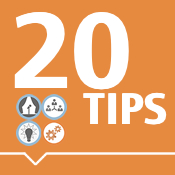 So you are going to be a Community Manager? Now what? Where do you start? How do you maximize the excitement and energy you have when beginning any new journey?
I have been in several sessions the past few weeks with people that know that they need a Community and I’m there to help with the strategy, design, roll-out and what they should expect to invest in time and effort. Of course the question is always asked,
So you are going to be a Community Manager? Now what? Where do you start? How do you maximize the excitement and energy you have when beginning any new journey?
I have been in several sessions the past few weeks with people that know that they need a Community and I’m there to help with the strategy, design, roll-out and what they should expect to invest in time and effort. Of course the question is always asked,
“How much time should we expect to spend managing the Community?” The answer is, “It depends.”I often use the analogy of designing and planting a new garden. You would not expect it to do well if you never watered or weeded it. You may choose to spend 15 minutes a week, or an hour a day. It depends on how much the garden and it’s beauty means to you. You can think about your online Community in much the same way, you will get out of it what you put in to it. That being said, it’s always good to see what other gardeners are doing, check out the yards in your neighborhood to see what’s working, what’s not, and mirror the best for yourself. So, when I think about where would I go looking for information on best Community Manager practices, of course I go to @TheCR and @RHappe for answers. And within 5 minutes of me tweeting today, I was pointed to several links that I want to share. These are fantastic for first timers and for those that think maybe they could be doing a better job with their existing Community. This was the first link they sent. This is a great deck that Rachel prepared and thankfully, Slideshare makes it easy for me to post it here for you to read:


 Economic challenges, alarming statistics and continuous bad news are all around us. How do you turn the negative environment around and find opportunities that can make a positive impact on your company?
Many businesses are utilizing tools that can bridge the gap in communication, can utilize data to reveal methods to either save or make money and can instantly connect and develop stronger business relationships with their customers and employees across the globe. These companies are experiencing success by implementing solid and detailed social media strategies.
According to the 2008 Cone Business and Social Media Study conducted by Opinion Research Corporation, 93 percent of social media users believe a company should have a presence in social media, while an overwhelming 85 percent believe a company should not only be present but also interact with its consumers via social media. In fact, 56 percent of users feel both a stronger connection with and better served by companies when they can interact with them in a social media environment.
Economic challenges, alarming statistics and continuous bad news are all around us. How do you turn the negative environment around and find opportunities that can make a positive impact on your company?
Many businesses are utilizing tools that can bridge the gap in communication, can utilize data to reveal methods to either save or make money and can instantly connect and develop stronger business relationships with their customers and employees across the globe. These companies are experiencing success by implementing solid and detailed social media strategies.
According to the 2008 Cone Business and Social Media Study conducted by Opinion Research Corporation, 93 percent of social media users believe a company should have a presence in social media, while an overwhelming 85 percent believe a company should not only be present but also interact with its consumers via social media. In fact, 56 percent of users feel both a stronger connection with and better served by companies when they can interact with them in a social media environment.

